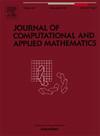基于多路延迟嵌入变换的高阶张量核范数彩色图像恢复
IF 2.6
2区 数学
Q1 MATHEMATICS, APPLIED
Journal of Computational and Applied Mathematics
Pub Date : 2025-09-23
DOI:10.1016/j.cam.2025.117078
引用次数: 0
摘要
近年来,基于多路延迟嵌入变换(MDT)的低秩张量补全在彩色图像恢复中得到了广泛关注。然而,现有的研究多集中在对MDT衍生的低秩的Hankel张量进行张量分解编码,这对预定义的秩很敏感,限制了恢复性能。针对这一问题,本文采用高阶张量核范数(HTNN)逼近汉克尔张量秩,提出了一种新的低秩张量补全模型MDT-HTNN。提出了一种基于乘法器交替方向法(ADMM)的高效算法来求解该模型,并对其收敛性进行了详细分析。在一系列彩色图像和MRI上的大量实验表明,我们提出的算法显著提高了恢复精度。具体而言,在多彩色图像的多采样率设置下,与经典MDT-Tucker方法相比,平均PSNR值提高了14.8%,CPU时间减少了89.5%。本文章由计算机程序翻译,如有差异,请以英文原文为准。
High-order tensor nuclear norm with Multiway Delay-embedding Transform for color image recovery
Recently, Multiway Delay-embedding Transform (MDT)-based low-rank tensor completion has achieved a lot of attention for color image recovery. However, existing studies mostly focus on tensor decomposition to encode the low-rankness of the Hankel tensor derived from MDT, which are sensitive to the predefined rank and limit the recovery performance. Aiming at addressing this issue, in this paper, we use the High-order Tensor Nuclear Norm (HTNN) to approximate the Hankel tensor rank, thus a new model named MDT-HTNN is proposed for low-rank tensor completion. Efficient algorithm based on the alternating direction method of multipliers (ADMM) is developed to solve the proposed model and its convergence analysis is discussed in detail. Extensive experiments on a series of color images and MRI illustrate that our proposed algorithm significantly improve the recovery accuracy. Specifically, under multiple sampling rate settings for multiple color images, the average PSNR value increased by 14.8% and the CPU time decreased by 89.5% compared with the classical MDT-Tucker method.
求助全文
通过发布文献求助,成功后即可免费获取论文全文。
去求助
来源期刊
CiteScore
5.40
自引率
4.20%
发文量
437
审稿时长
3.0 months
期刊介绍:
The Journal of Computational and Applied Mathematics publishes original papers of high scientific value in all areas of computational and applied mathematics. The main interest of the Journal is in papers that describe and analyze new computational techniques for solving scientific or engineering problems. Also the improved analysis, including the effectiveness and applicability, of existing methods and algorithms is of importance. The computational efficiency (e.g. the convergence, stability, accuracy, ...) should be proved and illustrated by nontrivial numerical examples. Papers describing only variants of existing methods, without adding significant new computational properties are not of interest.
The audience consists of: applied mathematicians, numerical analysts, computational scientists and engineers.

 求助内容:
求助内容: 应助结果提醒方式:
应助结果提醒方式:


